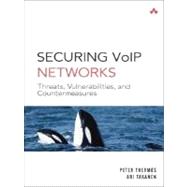
What is included with this book?
Peter Thermos is CTO of Palindrome Technologies, which provides information
security consulting services to government and commercial organizations.
Peter started his career at Bellcore (now Telcordia) as a member of the technical
staff and later as a principal technical expert on key information security and
assurance tasks. He is a frequent speaker at conferences and industry forums
including the IEEE, MIS, IEC, ISACA, VON, and others. Peter is also known
for his contributions to the security community for discovering software
vulnerabilities, the release of SiVuS (The First VoIP Vulnerability Scanner)
and the vopsecurity.org Forum. Peter holds a Masters Degree in Computer
Science from Columbia University where he is currently furthering his
graduate studies.
Ari Takanen is founder and CTO of Codenomicon. Since 1998, Ari has
focused on information security issues in next-generation networks and security
critical environments. He began at Oulu University Secure Programming Group
(OUSPG) as a contributing member to PROTOS research that studied information
security and reliability errors in WAP, SNMP, LDAP, and VoIP implementations.
Ari and his company, Codenomicon Ltd. provide and commercialize automated
tools using a systematic approach to test a multitude of interfaces on mission-critical
software, VoIP platforms, Internet-routing infrastructure, and 3G devices.
Codenomicon and the University of Oulu aim to ensure new technologies are
accepted by the general public, by providing means of measuring and ensuring
quality in networked software. Ari has been speaking at numerous security and
testing conferences on four continents and has been invited to speak at leading
universities and international corporations.
| Introduction | p. 1 |
| VoIP Architectures and Protocols | p. 29 |
| Threats and Attacks | p. 53 |
| VoIP Vulnerabilities | p. 127 |
| Signaling Protection Mechanisms | p. 165 |
| Media Protection Mechanisms | p. 217 |
| Key Management Mechanisms | p. 231 |
| VoIP and Network Security Controls | p. 263 |
| A Security Framework for Enterprise VoIP Networks 297 | |
| Provider Architectures and Security | p. 315 |
| Enterprise Architectures and Security | p. 334 |
| Index | p. 345 |
| Table of Contents provided by Publisher. All Rights Reserved. |
The New copy of this book will include any supplemental materials advertised. Please check the title of the book to determine if it should include any access cards, study guides, lab manuals, CDs, etc.
The Used, Rental and eBook copies of this book are not guaranteed to include any supplemental materials. Typically, only the book itself is included. This is true even if the title states it includes any access cards, study guides, lab manuals, CDs, etc.